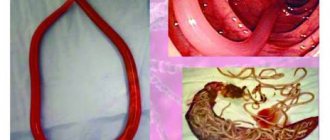In the group of congenital heart defects, tetralogy of Fallot ranks firmly in tenth place. The prevalence among “blue” defects is half. In medical reports and reference literature, the abbreviation CHD is often used, which is synonymous with the term “congenital heart disease.”
In the International Classification of Diseases ICD-10, it is included in the group of congenital anomalies under code Q21.3. An unusual combination of disturbances in the formation of the heart and main vessels was described in 1888 by A. Fallot as a separate syndrome. His name remains in the history of medicine.
What anomalies does the syndrome consist of, anatomical features
Tetralogy of Fallot includes a combination of four anomalies:
- defect in the interventricular septum;
- right-sided position of the aorta (as if “sitting astride” on both ventricles);
- stenosis or complete fusion of the pulmonary artery, it lengthens and narrows due to rotation of the aortic arch;
- pronounced right ventricular hypertrophy of the myocardium.
Among the combinations of defects with pulmonary artery stenosis and septal defects, there are 2 more forms, also described by Fallot.
The triad consists of:
- holes in the interatrial septum;
- pulmonary stenosis;
- right ventricular hypertrophy.
Pentad - adds to the first option the damaged integrity of the interatrial septum.
In most cases, the aorta receives a large volume of blood from the right side of the heart without sufficient oxygen concentration. Hypoxia is formed according to the circulatory type. Cyanosis is detected in a newborn child or in the first years of a baby’s life.
As a result, the infundibulum of the right ventricle narrows, and a cavity is formed above it, similar to an additional third ventricle. The increased load on the right ventricle contributes to its hypertrophy to the thickness of the left.
The only compensatory mechanism in this situation can be considered the appearance of a significant collateral (auxiliary) network of veins and arteries supplying blood to the lungs. The open botal duct temporarily maintains and improves hemodynamics.
Tetralogy of Fallot is typically associated with other developmental anomalies:
- non-closure of the ductus botallus;
- accessory superior vena cava;
- additional coronary arteries;
- Dandy Walker syndrome (hydrocephalus and underdevelopment of the cerebellum);
- in ¼ of patients the embryonic right aortic arch remains (Corvisart's disease);
- congenital dwarfism and mental retardation in children (Cornelia de Lange syndrome);
- defects of internal organs.
Publications in the media
Transposition of the great vessels (TMS) is a congenital heart disease characterized by discordance of the ventricular-arterial connection with concordance of the connection of the remaining segments of the heart. In other words, the aorta arises from the morphologically right ventricle, and the pulmonary trunk arises from the morphologically left one. Statistics • 7-15% of all congenital heart diseases • 9.9% of congenital heart diseases diagnosed in infancy • Male to female sex ratio at birth - 3:1 .
Etiology : causes of congenital heart disease (see Tetralogy of Fallot).
Pathogenesis • With corrected TMS, discordance of the ventricular-arterial connection is combined with discordance of the connection of the atria and ventricles (transposition of the aorta and pulmonary artery is accompanied by inversion of the ventricles), and blood circulation does not suffer if there are no associated defects • This article considers only complete TMS • Depending from changes in pulmonary blood flow, complete TMS with increased or normal pulmonary blood flow is distinguished (when combined with a patent ductus arteriosus, atrial and ventricular septal defects, aortopulmonary fistula) and complete TMS with reduced pulmonary blood flow, when accompanying septal defects are combined with stenosis of the left outlet ventricle (complex form of TMS) • If normally the systemic and pulmonary circulations are connected sequentially, then with TMS they function in parallel, being completely separated. Therefore, a prerequisite even for a short life is the presence of communications between the systemic and pulmonary circulation in the form of naturally existing or artificially created defects. In this case, blood is discharged during TMS in both directions • The larger the size of the shunt, the less pronounced the hypoxemia • The most favorable prognosis is noted in cases where a large defect of the interatrial or interventricular septum provides the necessary mixing of blood, and moderate stenosis of the pulmonary artery prevents excessive blood flow in the lungs .
Clinical picture • General cyanosis • Differentiated cyanosis, when the upper half of the body is more cyanotic than the lower, is pathognomonic for TMS in combination with patent ductus arteriosus • Tachycardia • Dyspnea • Increased size of the heart and liver • Edema, ascites • On auscultation - increased both tones, systolic murmur of organic or relative (with atrial septal defect) pulmonary artery stenosis, murmur of VSD or patent ductus arteriosus.
Instrumental diagnostics
• ECG •• Up to 1–1.5 months of life, changes may be absent •• Signs of hypertrophy and overload of the right sections.
• X-ray of the chest organs •• heart takes the shape of an egg lying on its side, with a narrow vascular bundle in the anteroposterior and wide in the lateral projection, and the aortic arch is almost always on the left (highly specific signs) •• Depletion (with pulmonary stenosis) or enrichment (with septal defects) of the vascular pattern of the lungs.
• EchoCG •• Visualization of the abnormal origin of the great vessels •• Assessment of the degree of hypertrophy of the walls and dilatation of the heart chambers •• Diagnosis of associated defects (see Ventricular septal defect, Atrial septal defect, Patent ductus arteriosus) or stenosis of the right ventricular outflow tract.
• Pulse oximetry , study of the gas composition of peripheral blood •• Low oxygen saturation (pathognomonic sign - less than 30%) and pO2 (pathognomonic sign - less than 20 mm Hg) in peripheral blood •• When combining TMS with patent ductus arteriosus - high difference blood parameters of the upper and lower extremities.
• Probing of the cavities of the heart •• Increase in pO2 and blood oxygen saturation in the right sections and decrease in the left •• Tests are performed with aminophylline and oxygen inhalation to determine the prognosis regarding the reversibility of pulmonary hypertension •• See also Ventricular septal defect, Atrial septal defect, The ductus arteriosus is open.
• Right and left atriography and ventriculography , ascending aortography , coronary angiography •• Visualization of the pathological flow of contrast from the right parts into the aorta, and from the left into the pulmonary artery •• Diagnosis of associated defects (see Ventricular septal defect, Atrial septal defect, Ductus arteriosus open) or stenosis of the right ventricular outflow tract •• Both posterior aortic sinuses facing the pulmonary artery become coronary, and there are six normal variants of the origin of the coronary arteries from the aortic sinuses •• In 15% of cases, anomalies of the origin of the coronary arteries are detected.
Drug therapy : in the presence of natural defects between the systemic and pulmonary circulation, in order to prevent their closure, an infusion of PgE1 (alprostadil) 0.05–0.1 mg/kg/min is performed.
Surgery _
• Indications : all patients with complete TMS.
• Contraindications : irreversible pulmonary hypertension.
• Methods of surgical treatment •• Palliative interventions - increasing the size of natural or creating artificial defects between the systemic and pulmonary circulation: ••• Park-Rashkind operation (percutaneous balloon atrioseptostomy), usually carried out within a period of up to 3 months, has no advantages over treatment with Pg ; ••• Blalock-Hanlon operation (open resection of the interatrial septum) is of only historical interest •• Radical correction consists of plastic surgery of the atria with a synthetic patch so that blood from the pulmonary veins enters the right atrium, and blood from the vena cava enters the left ( Mustard and Senning operations) •• Anatomical correction of TMS (Jatenet operation) consists of intersection with subsequent orthotopic replantation of the great vessels, simultaneous ligation of the patent ductus arteriosus, as well as transplantation of the ostia of the coronary arteries into the base of the pulmonary trunk •• When combining TMS with VSD, plastic surgery of the defect is performed septum with simultaneous anatomical correction of TMS according to Zatena •• In case of a complex form of TMS (combination with VSD and pulmonary artery stenosis), the Rastelli operation is indicated - plastic surgery of the septal defect with the formation of the left ventricular outflow tract with a synthetic or autopericardial patch, elimination of patency of the mouth of the pulmonary trunk, implantation of an artificial trunk between the right ventricle and the pulmonary trunk or right pulmonary artery.
Specific postoperative complications • Sick sinus syndrome • Stenosis of the orifices of the vena cava and pulmonary veins • Stenosis of the outflow tract of the right and left ventricles.
Prognosis • Clinically significant circulatory failure usually occurs by 1–1.5 months of life • Half of children die within the first month after birth • Two thirds do not survive to one year of age • The average life expectancy of these patients is 3–19 months • Mortality after Mustard operations and Senning does not exceed 10% • In the long term, good results are achieved in 85-90% of cases • Hospital mortality with anatomical correction of TMS according to Jaten - 2-3%, according to Rastelli - less than 10% • 5-year survival rate with anatomical correction of TMS - 80–90%.
Reduction . TMS - transposition of the great vessels.
ICD-10 • Q25.8 Other congenital anomalies of large arteries.
Causes
The causes of the anomaly are considered to be effects on the fetus in the early stages of pregnancy (from the second to the eighth week):
- infectious diseases of the expectant mother (rubella, measles, influenza, scarlet fever);
- taking alcohol or drugs;
- treatment with hormonal drugs, sedatives and sleeping pills;
- toxic effect of nicotine;
- intoxication with industrial toxic substances in hazardous industries;
- a hereditary predisposition is possible.
The use of pesticides in the garden without respiratory protection affects not only the health of the woman, but also her offspring
The important thing is that at a short period of time a woman may not notice pregnancy and independently provoke fetal pathology.
Types of tetralogy of Fallot
It is customary to distinguish 4 types of tetralogy of Fallot according to the characteristics of anatomical changes.
- Embryological - narrowing is caused by anterior displacement of the septum to the left and low localization. Maximum stenosis coincides with the level of the anatomical demarcation muscle ring. In this case, the structures of the pulmonary valve are practically unchanged, moderate hypoplasia is possible.
- Hypertrophic - pronounced hypertrophy of the exit zone from the right ventricle and the dividing muscle ring is added to the mechanism of the previous type.
- Tubular - obstruction is caused by incorrect division in the embryonic period of the common arterial trunk, due to which the pulmonary cone (the future of the pulmonary artery) turns out to be underdeveloped, narrowed and short. At the same time, it is possible to change the valve apparatus.
- Multicomponent - all of the listed factors are partially involved in the formation.
Choosing a clinic and cost of treatment
Treatment of tetralogy of Fallot requires the collaboration of cardiologists, cardiac surgeons, therapists and rehabilitation specialists. Large university clinics are leaders in the treatment of this heart defect:
- University Hospital Oldenburg, Department of Cardiac Surgery
- University Hospital Essen, Department of Cardiothoracic Surgery
- University Hospital Ulm, Department of Cardiothoracic Surgery
- University Clinic named after. Goethe Frankfurt am Main, Department of Cardiothoracic Surgery
- University Hospital Tübingen, Department of Adult and Pediatric Cardiothoracic Surgery
The estimated cost of examination and treatment is:
- Examination for suspected tetralogy of Fallot – from €485
- Radical surgical treatment of tetralogy of Fallot – from €14,104
- Cardiac rehabilitation after surgery – from €566 per day
The full cost of the medical program is determined based on the results of the examination, taking into account the duration of hospitalization, the presence of concomitant diseases and other factors.
Features of hemodynamics
The severity of the defect is determined by the degree of narrowing of the diameter of the pulmonary artery. To diagnose and determine treatment tactics, it is important to distinguish three types of anomalies:
- with complete fusion (atresia) of the arterial lumen: the most severe disorder, with a large interventricular foramen, the mixed blood of both ventricles is directed predominantly to the aorta, oxygen deficiency is pronounced, in the case of complete atresia, blood enters the lungs through the open ductus arteriosus or through collateral vessels;
- acyanotic form: with moderate stenosis, the obstacle to the blood flow from the right ventricle can be overcome by a lower pressure than in the aorta, then the blood discharge will take a favorable path from the artery to the vein, the defect variant is called “white”, since cyanosis of the skin does not form;
- cyanotic form with stenosis of varying degrees: caused by the progression of obstruction, discharge of blood from right to left; this causes a transition from the "white" form to the "blue" form.
Symptoms
The clinical picture appears:
- significant cyanosis - located around the lips, in the upper half of the body, intensifies when the child cries, feeds, strains;
- shortness of breath - has a paroxysmal nature associated with physical activity, the child takes the most comfortable “squatting” position, due to a temporary reflex additional spasm of the pulmonary artery and the cessation of blood oxygen saturation by 2 times;
- fingers in the shape of “drum sticks”;
- physical underdevelopment and weakness of children; running, outdoor games cause increased fatigue, dizziness;
- convulsions - associated with hypoxia of brain structures, blood thickening, and a tendency to thrombosis of cerebral vessels.
The form of the disease depends on the age of the child, and it determines the adequacy of compensation; in a newborn, cyanosis is visible on the face, hands and feet
There are:
- early manifestations in the form of cyanosis immediately after birth or in the first 12 months of life;
- The classic course is considered to be the manifestation of cyanosis at two to three years of age;
- severe form - paroxysmal clinical picture with shortness of breath and cyanosis;
- late - cyanosis appears only by 6 or 10 years;
- acyanotic form.
An attack of shortness of breath can occur at rest: the child becomes restless, cyanosis and shortness of breath intensify, the heart rate increases, loss of consciousness with convulsions and subsequent focal manifestations in the form of incomplete paralysis of the limbs is possible.
Diagnostics
The diagnosis is made by observing the child and the presence of objective signs. Information from relatives about development and activity, attacks with loss of consciousness and cyanosis are taken into account.
When examined in children, attention is drawn to the cyanotic nature of the lips and the altered shape of the terminal phalanges of the fingers. Rarely does a “heart hump” form.
On percussion, the borders of the heart are not changed or expanded in both directions. During auscultation, a rough systolic murmur is heard to the left of the sternum in the fourth intercostal space due to the passage of blood flow through the hole in the interventricular septum. It is better to listen to the patient in the supine position.
On the radiograph, the contours of the cardiac shadow resemble a “shoe” directed to the left
Due to the absence of the pulmonary artery arch, retraction occurs in the place where the vessels are usually located. A depleted lung appears more transparent. Enlargement of the heart to a large size does not occur.
A general blood test determines the adaptive response to hypoxia in the form of an increase in the number of red blood cells and an increase in hemoglobin.
Ultrasound diagnostics using a conventional ultrasound machine or Doppler ultrasound allows you to accurately determine changes in the chambers of the heart, abnormal development of blood vessels, the direction and magnitude of blood flow.
The ECG shows signs of right-sided cardiac hypertrophy, possible right bundle branch block, and the electrical axis is significantly deviated to the right.
Probing of the cavities of the heart with measurement of pressure in the chambers and vessels is carried out in specialized clinics when deciding on surgical treatment.
Less commonly, coronary angiography and magnetic resonance imaging may be required.
In differential diagnosis, it is necessary to exclude a number of diseases:
- transposition of the pulmonary artery causes a significant enlargement of the heart as the child grows;
- fusion at the level of the tricuspid valve promotes hypertrophy not of the right, but of the left ventricle;
- Eisenmenger's tetralogy - a defect accompanied not by fusion, but by dilation of the pulmonary artery; its pulsation and characteristic pattern of pulmonary fields are determined on an x-ray;
- stenosis of the pulmonary artery lumen is not accompanied by a “shoe” picture.
Doppler ultrasound helps to distinguish atypical forms.
Complex heart surgeries abroad with Booking Health
Selecting a medical facility and cardiac surgeon can be a daunting task for someone without relevant experience or medical knowledge. Treatment of children requires special attention, since not all clinics have equipment for complex heart interventions in children. Most clinics of this level are located in Germany.
Certified medical tourism operator Booking Health offers patients assistance in choosing a medical facility and doctor, preparing for travel, performing surgery and organizing follow-up care. Booking Health provides the following services:
- Selecting a suitable clinic based on the annual qualification profile (cardiology, cardiac surgery, pediatrics)
- Preliminary communication with a cardiologist and surgeon
- Making an appointment or booking a room in the cardiology department
- Preliminary preparation of a treatment program (without repeating previously performed diagnostic examinations), explanation of its stages
- Ensuring favorable prices for treatment and related services, eliminating overpayments (savings up to 50%)
- Independent external control of all medical interventions
- Insurance against an increase in the cost of the treatment program in case of complications (200,000 euros, valid for 4 years)
- Assistance in purchasing and shipping medications
- Communication with the clinic and doctor after completion of treatment
- Control of invoices and return of unspent funds
- Organization of rehabilitation, follow-up examinations, maintenance therapy
- Services of the highest level: booking air tickets and hotels, organizing transfers, translation services
To schedule treatment for yourself or your child, leave a request on the Booking Health website. A patient manager or medical consultant will contact you as soon as possible to discuss all the details. The main goal of Booking Health is to help you improve and maintain your health.
Treatment
Drug therapy for a patient with tetralogy of Fallot is carried out only for the purpose of preparing for surgery or in the postoperative period. The only goal is to support the myocardium, preventing possible thrombosis after attacks and impaired coronary and cerebral circulation.
The patient is shown:
- inhalation of an oxygen-air mixture through nasal catheters or in an oxygen tent; newborns are kept in special intensive care units to reduce hypoxia;
- A solution of Reopoliglyukin, Eufillin is administered intravenously (in the absence of tachycardia);
- due to tissue acidosis, sodium bicarbonate solution is required.
It is impossible to treat a patient without surgical assistance
Operations can be:
- emergency measure of temporary assistance;
- shunt type for relieving blood flow along a new channel;
- a radical choice with correction of the ventricular septal defect and the location of the aorta.
As an emergency, the creation of an artificial connection (anastomosis) between the aorta and pulmonary artery using a prosthesis is used.
It is used as the first stage of surgical intervention for newborns and young children. It is believed that such actions allow you to prepare the child and avoid complications during further treatment, reducing the risk to 5–7%.
It is necessary to decide on the final planned correction of the defect before the age of three years. Temporary anastomoses can be performed between the subclavian and pulmonary arteries.
Radical surgery includes plastic surgery of the right ventricular exit cone, elimination of a hole in the interventricular septum, and valvotomy (dissection of an overgrown pulmonary valve). It is performed on an open heart and requires the use of a heart-lung machine.
The first days after surgery already show improvement in hemodynamics
Advantages of heart surgery in German clinics
To objectively assess the success rates of cardiac surgery, the German Society of Thoracic and Cardiovascular Surgery has established a corresponding registry. It includes data on all heart operations performed in 78 German specialized centers and cardiac surgery departments. The aggregated data for 2021 shows a survival rate of 97.1%, which is quite impressive. Cardiac surgery in Germany is based on the following principles:
- High-quality preoperative examination to identify concomitant diseases. This is important for children with genetic disorders, since tetralogy of Fallot may be accompanied by DiGeorge syndrome or pulmonary pathology.
- Safe anesthesia . In children, general anesthesia should provide adequate sedation and analgesia with no withdrawal symptoms or hemodynamic changes. The optimal drug for the perioperative period is dexmedetomidine, other options include intravenous acetaminophen and propofol.
- Endovascular and minimally invasive interventions . Without a doubt, complex cardiac reconstruction is performed through an open surgical approach, with a clear view of the surgical field. Often two or three surgeons are involved in the operation. However, preliminary surgeries (such as Blalock-Taussig bypass) can be performed in a minimally invasive manner.
- Use of reliable vascular prostheses . In most cases, the patient's own tissue is sufficient to correct the structures of the heart. Otherwise, the surgeon uses certified synthetic prostheses.
- Aesthetic aspect . Regardless of the patient’s age, German surgeons strive to avoid the formation of large hypertrophic scars on the chest.
- Careful postoperative monitoring . In the early postoperative period, patients spend up to 24 hours in the intensive care unit. Thanks to this, medical personnel constantly monitor vital signs and promptly respond to their changes.
- Detailed recommendations regarding further observation, rehabilitation . After surgical treatment in Germany, postoperative rehabilitation and supportive drug treatment are always carried out. Cardiac rehabilitation with the participation of qualified medical professionals promotes rapid postoperative recovery and normal further development of the cardiovascular system in children. Regular medical examinations include laboratory (blood test, coagulogram, etc.) and instrumental (ECG, EchoCG, etc.) examinations, providing the doctor with objective information about the condition of the heart.
The updated annual registry of the German Society of Thoracic and Cardiovascular Surgery reflects current treatment success rates and serves as an independent benchmark for quality control of cardiac surgery. All medical institutions strive to achieve better results and improve their ratings.
Send a request for treatment








